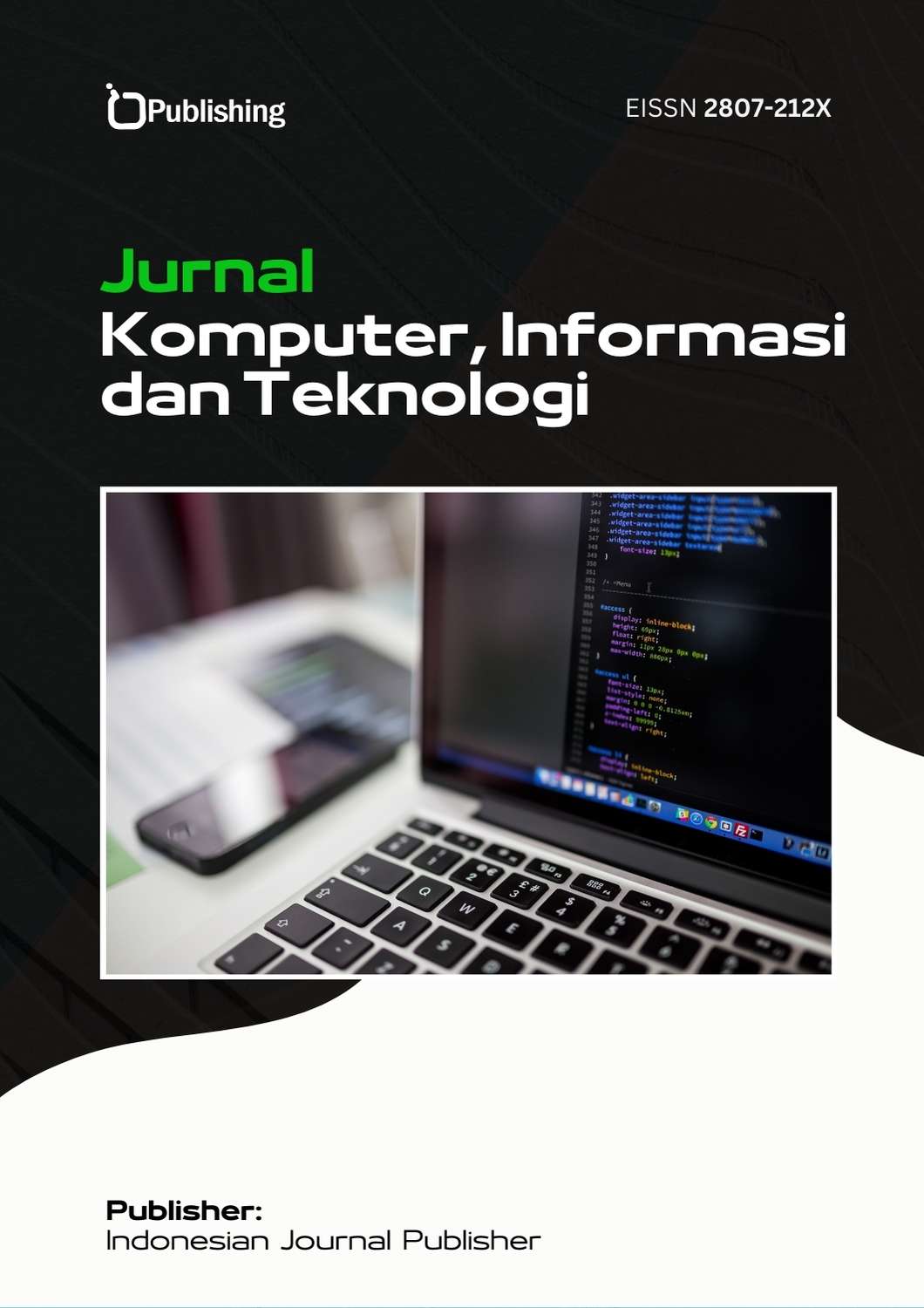Proses Pembuatan Konten Kreatif Visual untuk Pemasaran Digital pada Sosial Media Instagram @BOSSFOOD.OFFICIAL
DOI:
https://doi.org/10.53697/jkomitek.v5i1.2510Keywords:
Instagram, Konten Kreatif Visual, Pemasaran digitalAbstract
Studi ini menggunakan teori kreativitas WallaS (1962) dan model AIDA bertujuan untuk mempelajari proses pembuatan konten visual untuk pemasaran digital di instagram @BOSSFOOD.OFFICIAL. Metode penelitian yang digunakan adalah studi deskriptif kualitatif dengan teknik observasi partisipasi aktif, dan dokumentasi data engagement periode Januari sampai Mei 2025. Proses kreatif dimulai pada tahap persiapan dengan melakukan penelitian tentang tren, melakukan analisi audiens, dan mengupulkan ide untuk dimasukan ke dalam storyboard. Pada tahap inkubasi dua hari sebelum publikasi, ide dipelajari, tren dievaluasi, dan elemen visual disempurnakan. Pada tahap iluminasi, ide difinalisasi. Untuk menyempurnakan strategi, tehap verifikasi menggunakan data engagement untuk menyempurnakan strategi. Hasil dari analisis menunjukan bahwa penerapan model AIDA secara efektif meningkatkan engagement dan storytelling edukatif mampu menciptakan ikatan emosional lebih baik daripada kompetitor seperti Lotte Grosir. Hambatan seperti keterbatasan sumber daya manusia, manajemen waktu yang kurang baik, dan kurangnya eksplorasi visual mempengaruhi relevansi konten. Solusi yang disarankan meliputi manajemen waktu yang baik, penambahan sumber daya manusia yang berfokus pada bidang desain grafis, dan evaluasi mendalam terkait konten visual. Dengan solusi ini, diharapkan proses pembuatan konten Instagram @BOSSFOOD.OFFICIAL menjadi lebih efektif, menarik, dan berdampak positif pada tujuan pemasaran online
References
Ares, G. (2024). Colorful candy, teen vibes and cool memes: prevalence and content of Instagram posts featuring ultra-processed products targeted at adolescents. European Journal of Marketing, 58(2), 471-496, ISSN 0309-0566, https://doi.org/10.1108/EJM-12-2022-0899
Bermeo-Giraldo, M.C. (2022). Factors Influencing the Use of Digital Marketing by Small and Medium-Sized Enterprises during COVID-19. Informatics, 9(4), ISSN 2227-9709, https://doi.org/10.3390/informatics9040086
Botelho, L.V. (2023). Digital marketing of online food delivery services in a social media platform before and during COVID-19 pandemic in Brazil. Public Health Nutrition, 26(1), 1-11, ISSN 1368-9800, https://doi.org/10.1017/S1368980022002191
Burton, N. (2024). Exploring Paralympic digital sponsorship strategy: an analysis of social media activation. Managing Sport and Leisure, 29(1), 90-106, ISSN 2375-0472, https://doi.org/10.1080/23750472.2021.1990789
Chakti, A. G. (2019). The Book of Digital Marketing: Buku Pemasaran Digital. Makassar: Celebes Media Perkasa. Retrieved from https://books.google.co.id/books?hl=en&lr=&id=OQzBDwAAQBAJ&oi=fnd&pg=PR1&dq=pemasaran+digital&ots=we2gKe4Xii&sig=DI3325Zc0lshMJtBuv35a4rNuAQ&redir_esc=y#v=onepage&q&f=false
Choudhry, A. (2022). "i Felt a Little Crazy Following a 'Doll'". Proceedings of the ACM on Human-Computer Interaction, 6, ISSN 2573-0142, https://doi.org/10.1145/3492862
Danuri, M. (2019). Perkembangan dan Transformasi Teknologi Digital. 116-123. Retrieved from https://amikjtc.com/jurnal/index.php/jurnal/article/view/178/155
Gani, A. G. (2015). Pengenalan Teknologi Internet Serta Dampaknya. Jurnal Sistem Informasi, 71-86. Retrieved from https://journal.universitassuryadarma.ac.id/index.php/jsi/article/view/49
Hananto, B. A. (2019). Penggunaan Model AIDA Sebagai Struktur Komunikasi pada Media Sosial Instagram . Jurnal Nawala Visual, 72. doi:https://jurnal.idbbali.ac.id/index.php/nawalavisual/article/view/24/17
Hund, E. (2023). The Influencer Industry: The Quest for Authenticity on Social Media. The Influencer Industry: the Quest for Authenticity on Social Media, 1-218
Jacobson, J. (2022). Pup-ularity contest: The advertising practices of popular animal influencers on instagram. Technological Forecasting and Social Change, 174, ISSN 0040-1625, https://doi.org/10.1016/j.techfore.2021.121226
Kubler, K. (2023). Influencers and the attention economy: the meaning and management of attention on Instagram. Journal of Marketing Management, 39(11), 965-981, ISSN 0267-257X, https://doi.org/10.1080/0267257X.2022.2157864
Luangrath, A.W. (2023). Paralanguage Classifier (PARA): An Algorithm for Automatic Coding of Paralinguistic Nonverbal Parts of Speech in Text. Journal of Marketing Research, 60(2), 388-408, ISSN 0022-2437, https://doi.org/10.1177/00222437221116058
Márquez, I. (2023). Teenagers as curators: digitally mediated curation of the self on Instagram. Journal of Youth Studies, 26(7), 907-924, ISSN 1367-6261, https://doi.org/10.1080/13676261.2022.2053670
Nasution, A. F. (2023). Metode Penelitian Kualitatif. Bandung: CV Harfa Creative. Retrieved from http://repository.uinsu.ac.id/19091/1/buku%20metode%20penelitian%20kualitatif.Abdul%20Fattah.pdf
Rafiq, A. (2020). Dampak Media Sosial Terhadap Perubahan Sosial Suatu Masyarakat. Global Komunika, 18-29. Retrieved from https://ejournal.upnvj.ac.id/index.php/GlobalKomunika/article/view/1704
Robson, S. (2023). Brand post popularity on Facebook, Twitter, Instagram and LinkedIn: the case of start-ups. Online Information Review, 47(3), 486-504, ISSN 1468-4527, https://doi.org/10.1108/OIR-06-2021-0295
Romero-Jara, E. (2023). Connecting with fans in the digital age: an exploratory and comparative analysis of social media management in top football clubs. Humanities and Social Sciences Communications, 10(1), ISSN 2662-9992, https://doi.org/10.1057/s41599-023-02357-8
Romero-Jara, E. (2024). The more we post, the better? A comparative analysis of fan engagement on social media profiles of football leagues. International Journal of Sports Marketing and Sponsorship, 25(3), 578-599, ISSN 1464-6668, https://doi.org/10.1108/IJSMS-12-2023-0252
Rungruangjit, W. (2022). Building Stronger Brand Evangelism for Sustainable Marketing through Micro-Influencer-Generated Content on Instagram in the Fashion Industry. Sustainability (Switzerland), 14(23), ISSN 2071-1050, https://doi.org/10.3390/su142315770
Sari, M. S., & Zefri, M. (2019). Pengaruh Akuntabilitas, Pengetahuan, dan Pengalaman Pegawai Negeri Sipil Beserta Kelompok Masyarakat (Pokmas) Terhadap Kualitas Pengelola Dana Kelurahan Di Lingkungan Kecamatan Langkapura. Jurnal Ekonomi, 1-7. Retrieved from https://ejournal.borobudur.ac.id/index.php/1/article/view/608
Silva, M.J.d.B. (2023). Endorsement on Instagram and cultural dimensions: an analysis of digital influencers. Bottom Line, 36(1), 1-28, ISSN 0888-045X, https://doi.org/10.1108/BL-12-2021-0127
Tafesse, W. (2023). Content creators' participation in the creator economy: Examining the effect of creators’ content sharing frequency on user engagement behavior on digital platforms. Journal of Retailing and Consumer Services, 73, ISSN 0969-6989, https://doi.org/10.1016/j.jretconser.2023.103357
Widasari, E. (2017). Perancangan Konten Kreatif 16 Sub Sektor Ekonomi Kreatif BEKRAF Melalui Video Fulldome. Skripsi UDINUS, 4.
Zozaya-durazo, L. (2022). Disguising Commercial Intentions: Sponsorship Disclosure Practices of Mexican Instamoms. Media and Communication, 10(1), 124-135, ISSN 2183-2439, https://doi.org/10.17645/mac.v10i1.4640
Zulfa, N. Q., Zabidi, H., & Ma’mun, M. Y. (2021). Konten Kreatif Youtube Sebagai Sumber Penghasilan Ditinjau dari Etika Bisnis Islam. MUSYARAKAH: Journal of Sharia Economics (MJSE), 110-120. Retrieved from https://litabmas.umpo.ac.id/index.php/MUSYROKAH/article/view/4593/1991
Downloads
Published
How to Cite
Issue
Section
License
Copyright (c) 2025 Habsari Sarah Anjaly, Guruh Ramdani

This work is licensed under a Creative Commons Attribution 4.0 International License.













